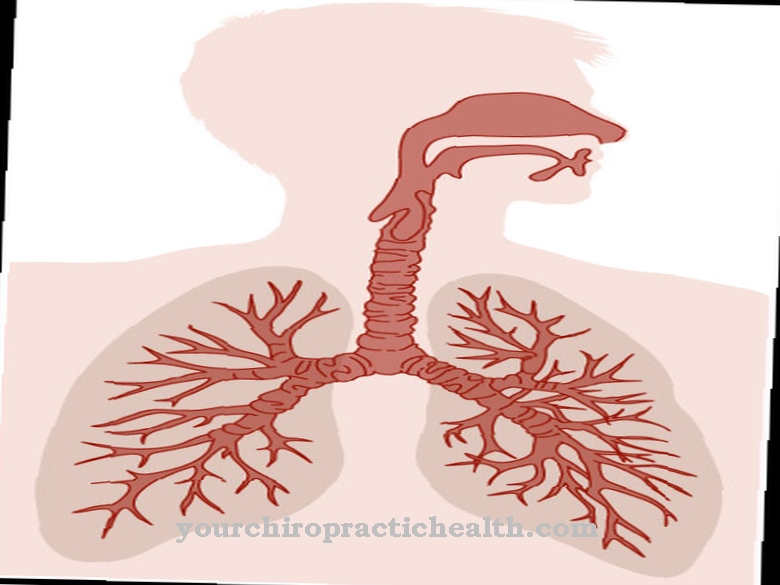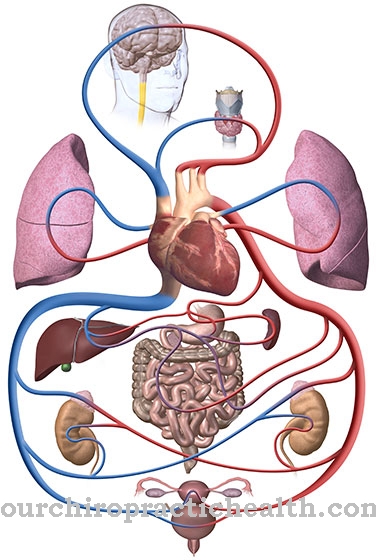Chronic bronchitis is a persistent inflammation of the airways that causes coughing and sputum for at least three months for two consecutive years. In the industrialized countries around one in ten people is affected by chronic bronchitis.
What is chronic bronchitis?

© sakurra - stock.adobe.com
With chronic bronchitis, the mucous membranes of the bronchial tubes are permanently inflamed. They therefore produce more slimy secretions that have to be coughed up. The function of the cilia, which normally have the task of removing pollutants from the lungs, is impaired.
In chronic bronchitis, the cilia are stuck together and viruses and bacteria can no longer be fended off so easily.
Chronic bronchitis is divided into three stages:
In the first stage, "simple chronic bronchitis", there are frequent coughing attacks and slimy expectoration. The bronchi are not narrowed in this phase and there is still no shortness of breath.
In the second stage of the disease, the bronchi are already narrowed. This stage of "chronic obstructive bronchitis" is particularly noticeable during physical exertion through shortness of breath.
In the last stage of chronic bronchitis, pulmonary emphysema develops, i.e. overinflation of the lungs, which in the long term also increases blood pressure and damages the heart. If chronic obstructive bronchitis and pulmonary emphysema occur at the same time, one speaks of COPD.
causes
Chronic bronchitis is usually caused by pollutants that get into the lungs. First of all, smoking should be mentioned here. The tar contained in the cigarettes causes the cilia to stick together and thus promotes inflammatory processes in the lungs.
In addition to smoking, pollutants in the air can also trigger chronic bronchitis. Fine dust, vapors and gases can severely impair the breathing system.
In addition, a genetic predisposition and a weak immune system with the consequence of frequent infections in the wet and cold season also play a role. In up to ninety percent of cases, however, the occurrence of chronic bronchitis can be traced back to years of intensive smoking.
Symptoms, ailments & signs
Chronic bronchitis is the most common lung disease, mostly affecting male smokers around the age of 40. Chronic bronchitis becomes particularly noticeable through so-called productive coughing, namely when mucus is secreted during the cough. In the event of an infection, this mucus is often yellowish-purulent or bloody.
If this is particularly tough, a doctor should be consulted as soon as possible. The productive cough occurs particularly intensely in the morning. In most cases, chronic bronchitis hardly or very rarely affects shortness of breath. However, if this is not treated for a long time, it can lead to shortness of breath and sometimes morning headaches.
Breathlessness is often the cause of weight loss, decreased performance and weakness. During physical exertion, shortness of breath often leads to acute [[[oxygen deficiency insufficient oxygen supply]] and a very fast breathing rhythm, also known as tachypnea. This is done quickly by the blue discoloration of the lips and the nail beds.
Other symptoms of chronic bronchitis include increased flow resistance in the pulmonary vessels, which can put considerable stress on the heart. In the late stages of this bronchitis, the stress on the heart can be seen in edema on the legs and congested neck vessels.
Diagnosis & course
The diagnosis of chronic bronchitis is understood as the interplay of specific examinations in combination with a conversation between doctor and patient. Since the symptoms of cough, phlegm and shortness of breath also permit other clinical pictures, such as asthma, it is particularly important to ask the patient about their habits and living conditions.
Listening to the lungs for lung noises, a lung function test as well as an X-ray examination and an electrocardiogram, or EKG for short, allow a further differentiation from other respiratory diseases. In addition, a blood test, in which the blood is tested for an oxygen deficiency characteristic of chronic bronchitis, leads to clarity.
If chronic bronchitis is still in its early stages, a complete cure is possible. If an existing illness is suspected, a doctor should be consulted as soon as possible in order to avoid further and long-term damage such as emphysema, lung cancer or pneumonia.
Complications
Various complications can arise in connection with chronic bronchitis. Patients with simple chronic bronchitis who do not avoid the toxins that trigger it, such as tobacco smoke, gases, dusts or vapors, must expect complications in particular. Chronic bronchitis then often turns into stage 2, that is, into chronic obstructive bronchitis. At this stage, the bronchi are permanently narrowed, resulting in shortness of breath and a drop in performance.
As the course progresses, chronic bronchitis can pass into stage 3. The lungs become over-inflated, leading to what is known as pulmonary emphysema. Pulmonary emphysema can cause heart complications. With an overinflated lungs, blood pressure in the pulmonary vessels increases. As a result, the heart becomes overloaded and weakened. Heart failure can occur.
Chronic bronchitis can lead to lung cancer (bronchial carcinoma). In addition, chronic bronchitis can cause inflammation of the lungs (pneumonia) and purulent bronchitis. With chronic bronchitis, the bronchi can bulge and so-called bronchiectasis forms. Other complications associated with chronic bronchitis include metabolic syndrome and osteoporosis. Patients with chronic bronchitis can be particularly susceptible to infections.
When should you go to the doctor?
Chronic bronchitis is a very serious condition that should always be treated by a doctor. Bronchitis itself is usually more troublesome than dangerous, but if left untreated it can lead to very serious complications.
A common cause of the chronic course of bronchitis is postponed colds, an inappropriately cured flu or heavy smoking. A chronic course of the disease can often be prevented if the patient goes to the doctor in good time. Anyone who keeps catching colds within short intervals, suffers from a severe cough that does not improve or is accompanied by tough sputum, should not try to treat these symptoms with the help of over-the-counter medications alone.
At the latest if the symptoms do not subside after three or four days or even get worse, professional medical help should always be sought. Even smokers should not simply dismiss a constant dry cough as harmless. If left untreated, it can quickly develop into bronchitis or another disease. Smokers should therefore always consult a doctor promptly if they have the first problems with their lungs and airways.
Doctors & therapists in your area
Treatment & Therapy
Chronic bronchitis is treated by avoiding harmful substances. Smoking should be given up. Passive smoking in company is also harmful for chronic bronchitis and should be avoided.
In addition, it is advisable to prevent infections that can put additional strain on the bronchi. Many patients find a stay by the sea or in the mountains to be a relief. In addition to avoiding harmful substances, chronic bronchitis can be treated with medication. Antibiotics, expectorant drugs and drugs to dilate the bronchi are used here.
The aim of drug treatment is on the one hand to combat newly occurring infections as quickly as possible, and on the other hand to alleviate existing symptoms of chronic bronchitis.
Outlook & forecast
The chances of recovery from chronic bronchitis depend on the strength of the immune system, the patient's lifestyle and medical care.
In many cases, a cure is possible if the consumption of nicotine is completely avoided. Inhaling other pollutants such as exhaust fumes or toxins from the craft sector as well as construction utensils must also be completely avoided for a good forecast. If there is comprehensive and good treatment, the patient with chronic bronchitis can achieve freedom from symptoms. However, if there are obstructions, there is a risk of developing COPD.
This is a chronic lung disease that causes narrowing of the lung.The disease is associated with a reduction in general life expectancy. If chronic bronchitis continues to spread, the cells of the airways and lungs are permanently damaged. This means that healing is only possible to a limited extent. Due to the damage to the cells on the cell walls, pulmonary emphysema can develop with lifelong health impairments.
Chronic bronchitis often leads to other illnesses in people with poor health. With a weakened immune system, the susceptibility to infection increases sharply. Osteoporosis or heart failure are also more common. As a result, the general health of the patient is largely responsible for a prognosis of chronic bronchitis.
prevention
The most effective prevention of chronic bronchitis is not to smoke and avoid pollutants. Strengthening the breathing system, for example through inhalations, can also be helpful. Basically, a strong immune system is important, which can be achieved through a healthy diet as well as adequate sleep and plenty of exercise. To avoid serious infections, a flu vaccination is useful.
Aftercare
If the chronic bronchitis is being treated and the patient has been stabilized, there are a few important things to consider for follow-up and prevention. It is essential to avoid exposing the patient to high levels of pollutant emissions. These include fine dust pollution (high traffic volume in city centers), work with emitting substances (paints, varnishes, disinfectants) and of course smoking. The patient should stay away from partying with a smoking audience or avoid the smoke-exposed area.
Passive smoking is just as harmful as active smoking. Other types of infections should also be avoided at all costs. In addition to avoiding pollution, medical precautions can also be taken in consultation with the treating doctor. Expectorants, antibiotics, and bronchodilator drugs are the drugs of choice here.
The main aim is to prevent a new infection or to combat it in a targeted and timely manner. The relief of the acute symptoms of the existing chronic bronchitis is also in the foreground. The famous "air change" is a therapeutic agent that should not be underestimated, especially for chronic bronchitis.
Visits to the sea with the soothing, salty air contribute to the patient's well-being. The same can be achieved with a longer stay in clear mountain air. It should be noted that chronic bronchitis weakens the patient's immune system, which can lead to further infections.
You can do that yourself
The self-help measures for chronic bronchitis depend on the stage of the disease. If the bronchi are already too badly damaged (collapsed, spastically narrowed or degenerated) from the ongoing stress, measures for self-help can at best have a soothing effect. This includes, for example, expectorants and anticonvulsants.
Steam inhalations, sprays and sweets that contain sage, and rubbing the chest and throat with sharp essential substances such as mint oil or eucalyptus oil have proven effective.
Treatment with homeopathic remedies can provide additional relief, but cannot replace regular treatment. The choice of means depends on the ailments.
The progression of chronic bronchitis can, however, be slowed down and in rare cases stopped. In addition to absolutely giving up cigarettes and avoiding other pollutants, breathing techniques are particularly helpful. The so-called lip brake is the best known among them.
Other breathing techniques can be learned with or without the help of an appropriate therapist and may include technical assistance. In this way, the bronchi can be kept open longer, which promotes cleaning and thus relief. The respiratory muscles are also strengthened.
Regular walks in the fresh air and sporting activities that promote lung volume should - despite the stress symptoms - be integrated into everyday life by those affected. Lung sports groups can be found in many places.


.jpg)

























